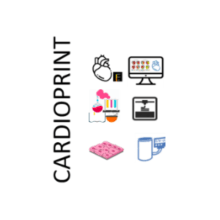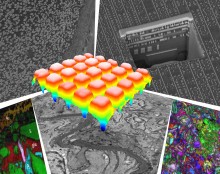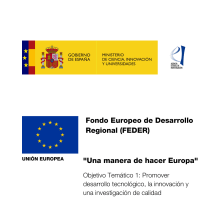Projects at a glance
HiMat - Hybrid layered materials for next generation electronics
HiMat focuses on the development of hybrid layered materials (HLMs) with tailored physical properties and their integration in lab-scale devices for opto- and spin- electronics or quantum computing. By taking advantage from the chemical flexibility of organic molecules, HiMat explores tailored HLMs obtained through a top-down approach as intercalated compounds and through a bottom-up approach as organic-inorganic metal-halide perovskites.
LSD - Low-dimensional Spin Devices
This project explored materials and architectures with low dimensionality and symmetry to develop spintronic devices. We created structures based on van der Waals materials or quiral materias in order to study the effect of symmetry breaking on the materials’ spin properties.
OPTOMETAMAG - Optical-control of thermally driven magnetic phase transitions in metamaterials
The project aims at developing hybrid systems combining the ultralow energy, speed, and control of plasmonic opto-heating with the unique property of nanoscale graded magnetic metamaterials to display magnetic phase transitions across precisely engineered critical temperatures.
NANOSPEC - Advanced near-field optical nanospectroscopy and novel applications in material sciences and nanophotonics
The objectives of the project include establishing correlative nano-FTIR, TERS, and TEPL spectroscopy, studying industrially relevant polymers, exploring organic conductors' conductivity, and investigating phonon polaritons in 2D materials. The project targets developing advanced near-field spectroscopy instrumentation and achieving vibrational strong coupling in nanoresonators and molecular vibrations.
CARDIOPRINT - Advanced multifunction 3D biofabrication for the generation of computationally modelled human-scale therapeutic cardiac tissues
CARDIOPRINT is born with the ambition of shaping a quantum leap in the fields of Additive Manufacturing and Biofabrication of therapeutic human cardiac tissues, at both the technological and applicative levels. The overall concept of this enterprising project is to develop a new multifunctional additive manufacturing technology able to provide the sufficient accuracy for the manufacturing of human tissues at an organ scale for the first time.
SNOMCELL - Near-field microscopy for label-free ultrastructural pathology
This project aims at establishing s-SNOM as a platform technology for label-free ultrastructural pathology. s-SNOM is an emerging technique -- co-developed at nanoGUNE -- that beats the diffraction limit and allows for obtaining infrared images with nanoscale spatial resolution. Applied to ultrathin cell sections, s-SNOM will allow for an unprecedented view on the chemical composition of the interior of a cell that cannot be easily calculated nor measured. Thus, s-SNOM will provide a reference data set that will help to validate already existing medical application of infrared microscopy and may even lead to the discovery of new nano-IR biomarkers.
SYNERFUN - Synergistic Surface Functionalization for Advanced Diagnistic, Catalytic and Packaging Materials
This project aims to leverage our expertise in surface functionalization and hybrid material fabrication to develop new systems for diagnostics, energy conversion, and food packaging. Our capabilities include synthesizing 0D materials (nanoparticles) and 2D materials (atomic scale thin films) and modifying surfaces with hybrid materials to introduce or enhance chemical and physical properties. Our focus will be on developing innovative materials with exciting applications in biomedical diagnostics and therapies, and concepts for enhancing common polymers used for intelligent food packaging in the future.
BRIDGE - Bridging the gap between synthetic polymers and biopolymers physical and chemical properties
The project BRIDGE is aimed at closing the gap between studying polymers and biopolymers. Traditionally, these materials are "at home" in the disciplins of soft matter physics and of biophysics, respectively. Our interdisciplinary approach opens new avenues, of which we explored morphology and dynamics. A special focus was on the role of water, as solvent, and as adsorbed layer.
FunMolSys - On-surface Synthesis of Functional Molecular Systems
This is a collaborative research project funded by the Spanish Research Agency (AEI) for synthetizing functional complex carbon-based molecular nanostructures with atomic precision and testing their potential operability as functional units in various technological applications, such as spintronics, topological engineering, (opto)electronics, thermoelectricity, and chemical and molecular sensing and filtering. FunMolSys combines the work of six Spanish research groups in Galicia (CiQUS at the University of Santiago de Compostela), Euskadi (the CFM, Centro de Física de Materiales - CSIC-UPV, and CIC nanoGUNE), Aragón (the ICMA, Instituto de Ciencia de Materiales de Aragón – CSIC-UZ), and Catalunya (the ICN2, Instituto Catalán de Nanociencia y Nanotecnología). In the last years, FunMolSys has produced novel strategies for synthesis of customized graphene platforms over metallic surfaces and identification of their new electronic and magnetic properties with a combination of multiple experimental methods, theoretical tools, and multidisciplinary expertise. Within FulMolSys, the research groups of Theory and nanoimaging, led by Profs. Artacho and Pascual, respectively, contributed with a sub-project entitled “Magnetism and topological states of on-surface engineered molecular nanosystems”
Evaporador - Evaporador para el crecimiento de películas delgadas en alto vacío
El proyecto tiene como finalidad la compra de un evaporador de alto vacío provisto de dos tipos diversos de evaporación de materiales y un equipo de ataque físico por iones. Las características de este equipo nos permitirán ampliar los materiales disponibles en nuestra sala blanca, así como acometer procesos de fabricación con condiciones ideales en cuanto a limpieza de intercapas y con un nivel ideal de rotación de usuarios.
SIESTA-PRO: Spanish Initiative for Electronic Simulations with Thousands of Atoms: Código Abierto Con Garantía y Soporte Profesional
The aim of SIESTA-PRO is taking the open-source SIESTA program (a program for the first-principles simulation of matter and materials) to high standards of competitiveness in international industrial scene. It is a collaboration led by Simune Atomistics Ltd, a company offering simulation services to high-tech industry, with three research institutions as partners. The research groups will develop new key strategic features into SIESTA, while Simune will develop tools to increase its usability in industrial environments.




